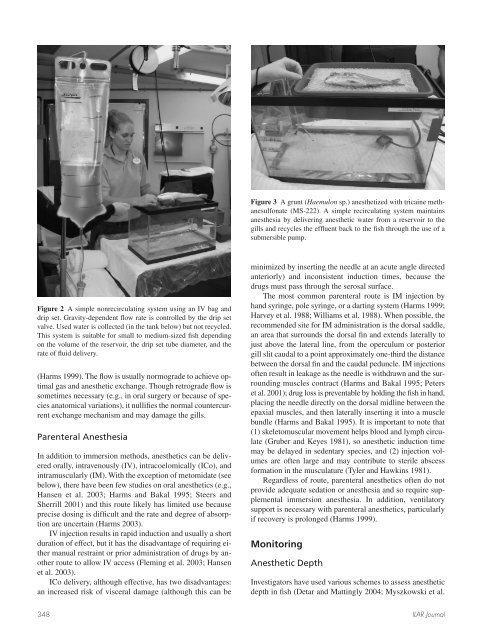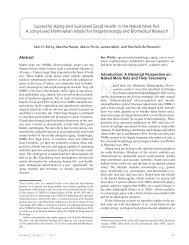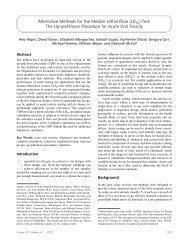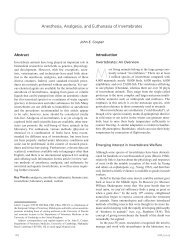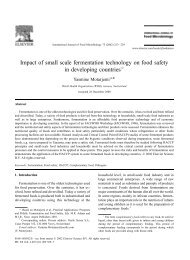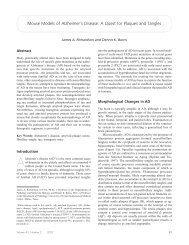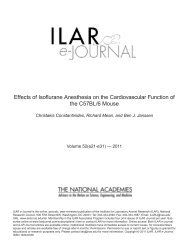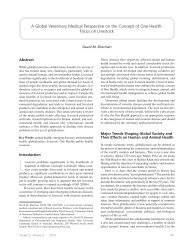Fish Sedation, Anesthesia, Analgesia, and Euthanasia ...
Fish Sedation, Anesthesia, Analgesia, and Euthanasia ...
Fish Sedation, Anesthesia, Analgesia, and Euthanasia ...
Create successful ePaper yourself
Turn your PDF publications into a flip-book with our unique Google optimized e-Paper software.
Figure 2 A simple nonrecirculating system using an IV bag <strong>and</strong><br />
drip set. Gravity-dependent fl ow rate is controlled by the drip set<br />
valve. Used water is collected (in the tank below) but not recycled.<br />
This system is suitable for small to medium-sized fi sh depending<br />
on the volume of the reservoir, the drip set tube diameter, <strong>and</strong> the<br />
rate of fl uid delivery.<br />
(Harms 1999). The fl ow is usually normograde to achieve optimal<br />
gas <strong>and</strong> anesthetic exchange. Though retrograde fl ow is<br />
sometimes necessary (e.g., in oral surgery or because of species<br />
anatomical variations), it nullifi es the normal countercurrent<br />
exchange mechanism <strong>and</strong> may damage the gills.<br />
Parenteral <strong>Anesthesia</strong><br />
In addition to immersion methods, anesthetics can be delivered<br />
orally, intravenously (IV), intracoelomically (ICo), <strong>and</strong><br />
intramuscularly (IM). With the exception of metomidate (see<br />
below), there have been few studies on oral anesthetics (e.g.,<br />
Hansen et al. 2003; Harms <strong>and</strong> Bakal 1995; Steers <strong>and</strong><br />
Sherrill 2001) <strong>and</strong> this route likely has limited use because<br />
precise dosing is diffi cult <strong>and</strong> the rate <strong>and</strong> degree of absorption<br />
are uncertain (Harms 2003).<br />
IV injection results in rapid induction <strong>and</strong> usually a short<br />
duration of effect, but it has the disadvantage of requiring either<br />
manual restraint or prior administration of drugs by another<br />
route to allow IV access (Fleming et al. 2003; Hansen<br />
et al. 2003).<br />
ICo delivery, although effective, has two disadvantages:<br />
an increased risk of visceral damage (although this can be<br />
Figure 3 A grunt (Haemulon sp.) anesthetized with tricaine methanesulfonate<br />
(MS-222). A simple recirculating system maintains<br />
anesthesia by delivering anesthetic water from a reservoir to the<br />
gills <strong>and</strong> recycles the effl uent back to the fi sh through the use of a<br />
submersible pump.<br />
minimized by inserting the needle at an acute angle directed<br />
anteriorly) <strong>and</strong> inconsistent induction times, because the<br />
drugs must pass through the serosal surface.<br />
The most common parenteral route is IM injection by<br />
h<strong>and</strong> syringe, pole syringe, or a darting system (Harms 1999;<br />
Harvey et al. 1988; Williams et al. 1988). When possible, the<br />
recommended site for IM administration is the dorsal saddle,<br />
an area that surrounds the dorsal fi n <strong>and</strong> extends laterally to<br />
just above the lateral line, from the operculum or posterior<br />
gill slit caudal to a point approximately one-third the distance<br />
between the dorsal fi n <strong>and</strong> the caudal peduncle. IM injections<br />
often result in leakage as the needle is withdrawn <strong>and</strong> the surrounding<br />
muscles contract (Harms <strong>and</strong> Bakal 1995; Peters<br />
et al. 2001); drug loss is preventable by holding the fi sh in h<strong>and</strong>,<br />
placing the needle directly on the dorsal midline between the<br />
epaxial muscles, <strong>and</strong> then laterally inserting it into a muscle<br />
bundle (Harms <strong>and</strong> Bakal 1995). It is important to note that<br />
(1) skeletomuscular movement helps blood <strong>and</strong> lymph circulate<br />
(Gruber <strong>and</strong> Keyes 1981), so anesthetic induction time<br />
may be delayed in sedentary species, <strong>and</strong> (2) injection volumes<br />
are often large <strong>and</strong> may contribute to sterile abscess<br />
formation in the musculature (Tyler <strong>and</strong> Hawkins 1981).<br />
Regardless of route, parenteral anesthetics often do not<br />
provide adequate sedation or anesthesia <strong>and</strong> so require supplemental<br />
immersion anesthesia. In addition, ventilatory<br />
support is necessary with parenteral anesthetics, particularly<br />
if recovery is prolonged (Harms 1999).<br />
Monitoring<br />
Anesthetic Depth<br />
Investigators have used various schemes to assess anesthetic<br />
depth in fi sh (Detar <strong>and</strong> Mattingly 2004; Myszkowski et al.<br />
348 ILAR Journal


